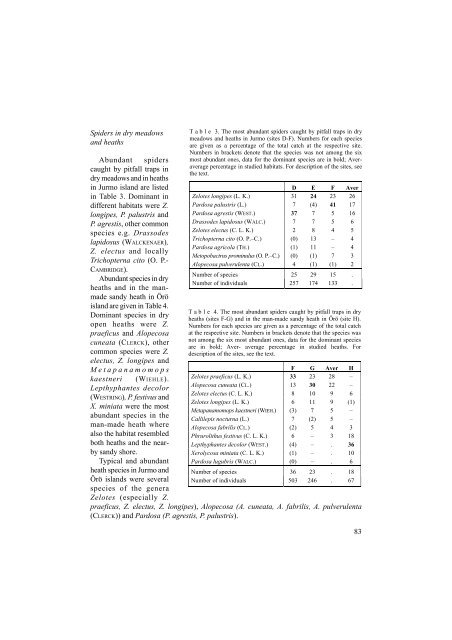spiders (araneae) of the fishpond eulittoral zone - European Society ...
spiders (araneae) of the fishpond eulittoral zone - European Society ...
spiders (araneae) of the fishpond eulittoral zone - European Society ...
Create successful ePaper yourself
Turn your PDF publications into a flip-book with our unique Google optimized e-Paper software.
Spiders in dry meadows<br />
and heaths<br />
Abundant <strong>spiders</strong><br />
caught by pitfall traps in<br />
dry meadows and in heaths<br />
in Jurmo island are listed<br />
in Table 3. Dominant in<br />
different habitats were Z.<br />
longipes, P. palustris and<br />
P. agrestis, o<strong>the</strong>r common<br />
species e.g. Drassodes<br />
lapidosus (WALCKENAER),<br />
Z. electus and locally<br />
Trichopterna cito (O. P.-<br />
CAMBRIDGE).<br />
Abundant species in dry<br />
heaths and in <strong>the</strong> manmade<br />
sandy heath in Örö<br />
island are given in Table 4.<br />
Dominant species in dry<br />
open heaths were Z.<br />
praeficus and Alopecosa<br />
cuneata (CLERCK), o<strong>the</strong>r<br />
common species were Z.<br />
electus, Z. longipes and<br />
Metapanamomops<br />
kaestneri (WIEHLE).<br />
Lepthyphantes decolor<br />
(WESTRING), P. festivus and<br />
X. miniata were <strong>the</strong> most<br />
abundant species in <strong>the</strong><br />
man-made heath where<br />
also <strong>the</strong> habitat resembled<br />
both heaths and <strong>the</strong> nearby<br />
sandy shore.<br />
Typical and abundant<br />
heath species in Jurmo and<br />
Örö islands were several<br />
species <strong>of</strong> <strong>the</strong> genera<br />
Zelotes (especially Z.<br />
T a b l e 3. The most abundant <strong>spiders</strong> caught by pitfall traps in dry<br />
meadows and heaths in Jurmo (sites D-F). Numbers for each species<br />
are given as a percentage <strong>of</strong> <strong>the</strong> total catch at <strong>the</strong> respective site.<br />
Numbers in brackets denote that <strong>the</strong> species was not among <strong>the</strong> six<br />
most abundant ones, data for <strong>the</strong> dominant species are in bold; Averaverage<br />
percentage in studied habitats. For description <strong>of</strong> <strong>the</strong> sites, see<br />
<strong>the</strong> text.<br />
D E F Aver<br />
Zelotes longipes (L. K.) 31 24 23 26<br />
Pardosa palustris (L.) 7 (4) 41 17<br />
Pardosa agrestis (WEST.) 37 7 5 16<br />
Drassodes lapidosus (WALC.) 7 7 5 6<br />
Zelotes electus (C. L. K.) 2 8 4 5<br />
Trichopterna cito (O. P.–C.) (0) 13 – 4<br />
Pardosa agricola (TH.) (1) 11 – 4<br />
Metopobactrus prominulus (O. P.–C.) (0) (1) 7 3<br />
Alopecosa pulverulenta (CL.) 4 (1) (1) 2<br />
Number <strong>of</strong> species 25 29 15 .<br />
Number <strong>of</strong> individuals 257 174 133 .<br />
T a b l e 4. The most abundant <strong>spiders</strong> caught by pitfall traps in dry<br />
heaths (sites F-G) and in <strong>the</strong> man-made sandy heath in Örö (site H).<br />
Numbers for each species are given as a percentage <strong>of</strong> <strong>the</strong> total catch<br />
at <strong>the</strong> respective site. Numbers in brackets denote that <strong>the</strong> species was<br />
not among <strong>the</strong> six most abundant ones, data for <strong>the</strong> dominant species<br />
are in bold; Aver- average percentage in studied heaths. For<br />
description <strong>of</strong> <strong>the</strong> sites, see <strong>the</strong> text.<br />
F G Aver H<br />
Zelotes praeficus (L. K.) 33 23 28 –<br />
Alopecosa cuneata (CL.) 13 30 22 –<br />
Zelotes electus (C. L. K.) 8 10 9 6<br />
Zelotes longipes (L. K.) 6 11 9 (1)<br />
Metapanamomops kaestneri (WIEH.) (3) 7 5 –<br />
Callilepis nocturna (L.) 7 (2) 5 –<br />
Alopecosa fabrilis (CL.) (2) 5 4 3<br />
Phrurolithus festivus (C. L. K.) 6 – 3 18<br />
Lepthyphantes decolor (WEST.) (4) – . 36<br />
Xerolycosa miniata (C. L. K.) (1) – . 10<br />
Pardosa lugubris (WALC.) (0) – . 6<br />
Number <strong>of</strong> species 36 23 . 18<br />
Number <strong>of</strong> individuals 503 246 . 67<br />
praeficus, Z. electus, Z. longipes), Alopecosa (A. cuneata, A. fabrilis, A. pulverulenta<br />
(CLERCK)) and Pardosa (P. agrestis, P. palustris).<br />
83
















